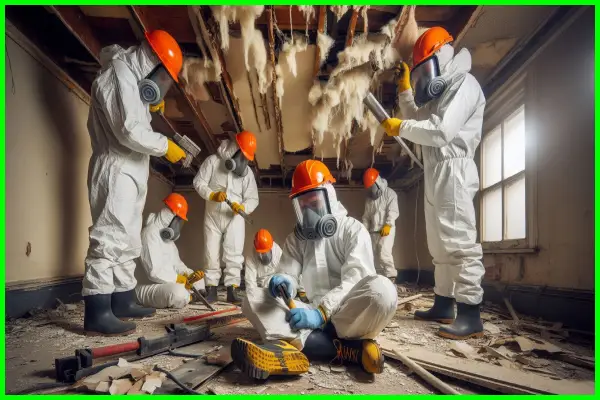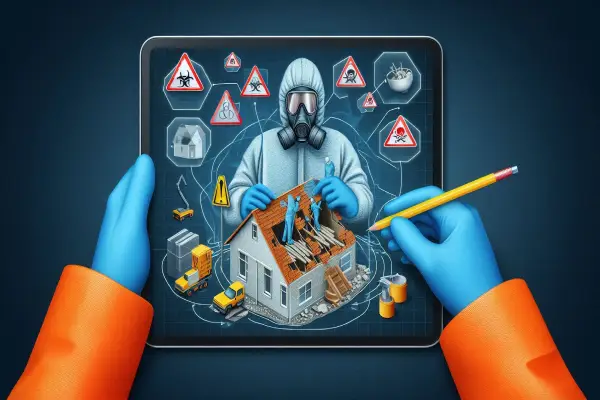Asbestos, a once-popular building material, poses significant health risks when disturbed or inhaled, highlighting the need for asbestos awareness and regular asbestos sampling.
Asbestos testing services, including the use of an asbestos testing kit, play a vital role in identifying potential hazards before they become a threat.
Understanding why asbestos testing is essential and learning about the asbestos sampling process and costs involved is important.
Additionally, the potential consequences of asbestos exposure, including risk assessments and asbestos remediation, and how to ensure safe removal if needed will be discussed.
Equip yourself with the knowledge to make informed decisions about your environment and health, safeguarding against airborne fibres and health risks.
What is Asbestos Testing Service?
Asbestos Testing Services are comprehensive solutions designed to identify and analyse asbestos-containing materials (ACMs) in various environments, particularly in the UK, to ensure compliance with health and safety regulations.
These services typically involve a meticulous sampling process, where trained surveyors collect samples from buildings, construction materials, and other potentially hazardous locations, often using an asbestos testing kit.
Once collected, these samples are submitted to a UKAS accredited laboratory, known for its high standards in asbestos analysis, where they undergo qualitative and quantitative testing to provide accurate results essential for ensuring safe environments and health protection. Sample submission is a critical step in this process to ensure proper laboratory testing.
Why is Asbestos Testing Important?
Asbestos testing is crucial for identifying potential health risks associated with exposure to airborne fibres, which can lead to serious illnesses such as asbestosis and mesothelioma. Given the UK’s stringent compliance obligations regarding asbestos-containing materials (ACMs), conducting regular testing, including air monitoring, is vital for maintaining environmental safety in both residential and commercial properties.
Furthermore, accurate risk assessments enable property owners and managers to make informed decisions about asbestos remediation and necessary precautions to protect occupants from dangerous dust exposure. Professional services often offer aftercare support to ensure health protection.
What are the Potential Risks of Asbestos?
The potential risks of asbestos are primarily due to the inhalation of airborne fibres, which can lead to severe health conditions including lung cancer, mesothelioma, and other respiratory diseases. Asbestos is a naturally occurring mineral used in various building materials such as insulation, flooring, and roofing, which can release harmful fibres into the air when disturbed or damaged. Understanding these risks is essential for ensuring environmental safety and protecting individuals from the long-term effects of asbestos exposure. Proper management and remediation practices are crucial in environments where asbestos might be encountered, often requiring the use of mobile laboratories for on-site testing.
Asbestos comprises several types of fibres, notably chrysotile, crocidolite, and amosite, each posing unique hazards. Chrysotile, commonly known as white asbestos, is the most prevalent form and is often found in roofing materials and insulation.
- Crocidolite, or blue asbestos, is recognised for its strength and resistance to heat but is also one of the most dangerous, associated with high rates of mesothelioma.
- Amosite, often referred to as brown asbestos, is primarily used in cement sheets and insulation boards, carrying similar health risks.
Material testing for these fibres can significantly reduce the risks associated with asbestos exposure.
Each type contributes to the overall risk profile of asbestos exposure, underscoring the need for vigilant risk management, including regular laboratory analysis and independent laboratory verification.
In workplaces or homes where these materials are present, it is imperative to conduct frequent inspections and implement safety measures to minimise the chances of fibre release. Failure to manage these risks can have devastating health implications for both workers and occupants.
How Does Asbestos Testing Work?
Asbestos testing typically begins with a systematic sampling process, where trained surveyors collect suspected asbestos-containing materials (ACMs) from various locations, including residential and commercial properties. These trained professionals often inspect areas such as ceilings, walls, pipes, and floors to identify potential sources of asbestos. The collected samples are then carefully packaged in sample bags with detailed instructions, ensuring they reach a UKAS-accredited laboratory for analysis. Mobile laboratories are sometimes used for quicker onsite testing.
Once in the laboratory, the samples undergo a rigorous testing process, which may include both qualitative and quantitative testing methods to detect the presence of asbestos fibres and provide accurate results to clients. Accurate analysis results are crucial for health protection and compliance obligations.
After the samples are transported, the laboratory technicians employ advanced techniques such as:
- Polarised Light Microscopy (PLM) for initial identification of asbestos fibres.
- Transmission Electron Microscopy (TEM) for more detailed analysis when required.
This meticulous approach ensures that every aspect of the sample is scrutinised, allowing for precise quantification of asbestos content. Obtaining accurate test results is critical, not only for legal compliance but also for ensuring safety in both residential and commercial environments. Full aftercare support is often available to address any follow-up needs.
Understanding the risks associated with asbestos exposure can significantly impact health and safety regulations, underscoring the necessity for thorough testing and adherence to safety protocols.
Who Should Get Asbestos Testing?
Asbestos testing is essential for a variety of stakeholders, including property owners, landlords, construction companies, and anyone involved in building maintenance or renovation projects. Given the health protection concerns associated with asbestos exposure, individuals responsible for managing properties that predate the 2000s are particularly urged to conduct thorough asbestos testing to ensure compliance with health and safety regulations. Construction testing is particularly critical in these scenarios.
Additionally, construction testing prior to any renovation or demolition work is critical to identifying and mitigating risks related to asbestos-containing materials, thereby safeguarding workers and the public. Testing services often provide fast turnaround on results to facilitate timely actions.
How to Choose a Reliable Asbestos Testing Service?
Choosing a reliable asbestos testing service is paramount for ensuring accurate results and compliance with industry standards. When selecting a service provider, it is crucial to verify that they operate a UKAS accredited laboratory, as this signifies adherence to strict quality and safety protocols in asbestos analysis. Independent laboratory certifications can further add to the credibility of the service provider.
Additionally, consider the professionalism of their services, including the competence of trained surveyors, speed of testing with a quick turnaround on results, and the provision of detailed reports that outline the findings and recommendations for any necessary remediation actions.
What Certifications and Accreditations Should the Service Have?
When selecting an asbestos testing service, it is essential to ensure that the laboratory conducting the analysis holds UKAS accreditation, confirming its compliance with industry standards and quality assurance in asbestos testing methodologies.
This important certification demonstrates that the laboratory has met stringent criteria, encompassing everything from staff competency to rigorous testing protocols. By choosing a UKAS accredited service, clients can have peace of mind knowing they are receiving results that adhere to the highest quality benchmarks, thus minimising the risk of misinformation.
- Accredited laboratories regularly participate in proficiency testing
- They follow strict operational procedures
- They invest in continuous staff training and development
Along with UKAS accreditation, other certifications can further enhance the credibility of an asbestos testing service by affirming adherence to relevant regulations and safety standards. Consequently, these credentials collectively contribute to the reliability and integrity of testing results, ensuring that proper measures are taken for health and environmental protection.
What is the Turnaround Time for Results?
The turnaround time for asbestos testing results can vary depending on the laboratory and the complexity of the analysis; however, most UKAS accredited laboratories strive to provide a quick turnaround, often within 24 to 72 hours. Prompt access to results is crucial for clients needing to make timely decisions regarding asbestos remediation and compliance obligations. Fast turnaround is often a key consideration for clients. Understanding the expected timeframe for laboratory analysis helps clients plan their next steps effectively and ensures that they can maintain safe environments without unnecessary delays.
In general, various factors can affect the timing of results, such as:
- Sample Type: Different materials require distinct analytical methods, which can influence processing time.
- Laboratory Workload: During peak times, a higher volume of samples may extend turnaround periods.
- Methodology: Some analysis techniques, such as bulk sampling or air monitoring, may necessitate more extensive testing protocols.
It is essential for clients to discuss their specific needs with the testing facility to ascertain realistic timelines. Timeliness ensures risks associated with asbestos exposure are minimised, allowing for swift remediation actions when necessary. Laboratory services often provide detailed reports as part of their professional services.
Do They Provide Detailed Reports?
A reliable asbestos testing service should provide detailed reports that outline the analysis results comprehensively, enabling clients to understand the implications of their findings. These reports should include information on the types of asbestos fibres detected (such as Chrysotile, Crocidolite, and Amosite), quantities, and recommendations for management or remediation strategies. Detailed reporting is integral to the professional services offered by the testing laboratory, ensuring that clients can make informed decisions regarding compliance obligations and health protection measures.
To further enhance the effectiveness of these reports, clarity and thoroughness play pivotal roles. For instance, each report should not only highlight the types of asbestos identified but also include:
- Visual aids such as charts or graphs to present data in an easily digestible format.
- A clear explanation of the health risks associated with different types of asbestos, including Chrysotile, Crocidolite, and Amosite, facilitating better understanding.
- Contextual information that relates findings to building materials or locations within the property.
- Visual aids such as charts or graphs to present data in an easily digestible format.
- A clear explanation of the health risks associated with different types of asbestos, facilitating better understanding.
- Contextual information that relates findings to building materials or locations within the property.
This emphasis on clear communication ensures that clients fully grasp the necessary actions to protect themselves and comply with regulations, making it critical for the long-term safety of all involved.
What to Expect During the Asbestos Testing Process?
During the asbestos testing process, clients can expect a systematic and thorough approach to ensure environmental safety and compliance with health regulations. Initially, trained surveyors will conduct a detailed inspection of the premises to identify potential asbestos-containing materials (ACMs) before performing the sampling process.
Samples will be carefully collected according to industry standards, securely packaged, and sent to a UKAS accredited laboratory for comprehensive analysis. Throughout this process, clear communication will be maintained to ensure that clients understand each step and its significance in safeguarding their health and property.
How Much Does Asbestos Testing Cost?
The cost of asbestos testing can vary widely based on several factors, including the size of the property, the number of samples required, and the specific services offered by the testing laboratory.
Generally, clients can expect to invest in professional services that cover the sampling process, laboratory analysis, and reporting of results. Pricing transparency is essential; therefore, prospective clients should seek detailed quotes that outline what is included in the costs and any additional fees for services such as expedited analysis or further testing. Trusted providers like RB Asbestos and North Star Environmental can offer detailed breakdowns of these costs.
What Happens if Asbestos is Found?
If asbestos is found during testing, immediate action is necessary to manage the situation effectively and ensure health protection for occupants and workers. The first step typically involves notifying relevant stakeholders and implementing containment measures to prevent further exposure to airborne fibres.
Following identification, asbestos remediation services should be engaged to assess the extent of the contamination and determine the appropriate course of action, whether that involves removal, encapsulation, or repair, all while adhering to compliance obligations and maintaining environmental safety. Trusted companies like Construction Testing Solutions can provide these remediation services effectively.
How to Safely Remove Asbestos?
Safely removing asbestos requires a meticulous approach carried out by trained professionals who understand the risks and regulations associated with asbestos-containing materials (ACMs). The process typically involves thorough planning, which includes assessing the site, establishing containment zones to prevent dust exposure, and using specialised equipment and protective gear. Implementing these safety measures is crucial for ensuring health protection and minimising the risk of airborne fibres escaping during the asbestos removal process. Moreover, using cleaning wipes to clean the area reduces the risk of secondary contamination.
The techniques employed during asbestos removal are designed to ensure effective and safe handling of harmful materials. First, professionals create a detailed asbestos management plan that outlines each step of the removal process. This is followed by:
- Pre-cleaning: This involves cleaning the area prior to any work to limit contamination.
- Use of Negative Air Pressure: Specialised machines filter air to prevent fibres from escaping the work area.
- Wet Removal: Keeping materials damp reduces dust emissions and aids in safe removal.
- Air Testing: Conducting air testing before and after the removal ensures that the environment is safe and free from asbestos fibers.
Equipped with personal protective equipment (PPE), including respirators and full-body suits, the certified professionals carry out the work with utmost care. The importance of hiring experts cannot be overstated, as they not only adhere to rigorous safety standards but also guarantee compliance with local environmental regulations. This protects both the workers involved and nearby residents, ensuring that hazardous materials are dealt with responsibly. Organizations such as BOHS and RSPH provide certifications for professionals to ensure high industry standards are met.
What are the Costs of Asbestos Removal?
The costs associated with asbestos removal can vary significantly based on factors such as the location, the extent of contamination, and the specific methods employed for remediation.
Typically, clients can expect to incur expenses for professional services, which include site assessment, removal, disposal of asbestos waste, and post-removal air monitoring to ensure safety. Understanding these costs, along with the importance of compliance obligations, is essential for property owners facing asbestos issues.
To gain a comprehensive understanding of asbestos removal costs, it is crucial to consider several elements that influence pricing. These include:
- Labour Costs: Skilled professionals are required for safe removal. Their expertise ensures that the process follows strict regulations, thus impacting overall labour expenses.
- Materials: Depending on the severity of contamination, various protective materials and disposal containers may need to be utilised, contributing to the financial outlay.
- Follow-Up Services: After removal, properties often need air quality testing and clearance certificates, which are additional costs that property owners should integrate into their budget planning. Partnering with industry-rated providers like UKAS ensures that all services adhere to environmental standards.
Ultimately, a detailed quote factoring in all these aspects will help in adequately budgeting for necessary remediation efforts.
What are the Potential Health Risks of Asbestos Exposure?
Asbestos exposure poses significant health risks, particularly when airborne fibres are inhaled, which can lead to various serious respiratory diseases, including lung cancer and mesothelioma. The dangers of asbestos are especially pronounced in occupational settings where individuals may encounter asbestos-containing materials (ACMs) without adequate protection. Prioritising health protection through proper testing, removal, and awareness about asbestos-related risks is crucial for preventing long-term health complications associated with exposure. Partnering with certified professionals from organizations like UKAS and RSPH ensures compliance with environmental standards.
The specific health conditions linked to asbestos exposure extend beyond the well-known lung cancer and mesothelioma. In fact, exposure can also result in asbestosis, a chronic lung condition characterised by inflammation and scarring of lung tissue, leading to significant respiratory issues over time. Symptoms of these disorders often begin years after initial exposure, making early detection challenging. Regular qualitative testing can help in early detection and management of these conditions.
The importance of understanding risk factors, such as occupational hazards and the duration of exposure, cannot be overstated. Engaging services like asbestos surveys and regular health screenings are essential preventive measures.
- Important safety measures should include regular health screenings for at-risk workers, the use of personal protective equipment (PPE), and the complete removal of asbestos materials from buildings. Utilising UKAS accredited laboratories for testing ensures accuracy and reliability.
- Awareness campaigns can educate individuals on the potential dangers of asbestos and the importance of working with certified professionals for management and removal. Leading organizations such as RB Asbestos and North Star Environmental can provide educational resources.
By taking proactive steps, individuals and communities can significantly reduce the dangers associated with asbestos and protect public health effectively.
Frequently Asked Questions
What is an Asbestos Testing Service?
An Asbestos Testing Service is a professional company that specialises in testing for the presence of asbestos in buildings and structures. Asbestos is a harmful mineral, commonly including types such as CHRYSOTILE, CROCIDOLITE, and AMOSITE, that can be found in many building materials and can cause serious health problems if not properly removed.
Why is it important to hire an Asbestos Testing Service?
It is crucial to hire an Asbestos Testing Service to ensure the safety of yourself, your family, and anyone who comes into contact with your property. Asbestos exposure can lead to serious health issues, including respiratory problems and cancer. Reputable services are often UKAS accredited, providing an additional level of assurance.
What can I expect during an Asbestos Testing Service?
An Asbestos Testing Service will first conduct a visual inspection of the property to identify any potential areas of concern. They will then collect samples of suspected materials, including client samples, and send them to a UKAS accredited laboratory for testing. Once results are obtained, they will provide a detailed report of their findings, often following industry rated standards.
How long does it take to get results from an Asbestos Testing Service?
The amount of time it takes to get results from an Asbestos Testing Service can vary, but typically it takes 1-2 days for the samples to be analysed in the lab. The overall process, from initial inspection to final report, can take anywhere from 3-5 days. Leading companies, such as RB Asbestos and North Star Environmental, adhere to these timeframes.
What happens if asbestos is found in my property?
If asbestos is found in your property, an Asbestos Testing Service can provide recommendations for proper asbestos removal and remediation. It is important to follow these recommendations to ensure the safe removal of the asbestos and prevent any further exposure. Companies like Construction Testing Solutions can provide comprehensive services for asbestos removal.
Can I perform asbestos testing on my own?
While some DIY asbestos testing kits are available, it is highly recommended to hire a professional Asbestos Testing Service for accurate and reliable results. These professionals, often certified by organizations like BOHS and RSPH, have the proper training and equipment to safely test and handle asbestos, ensuring the safety of you and your property. Testing typically includes analysis of ACMs (Asbestos-Containing Materials) to confirm the presence of hazardous materials.





